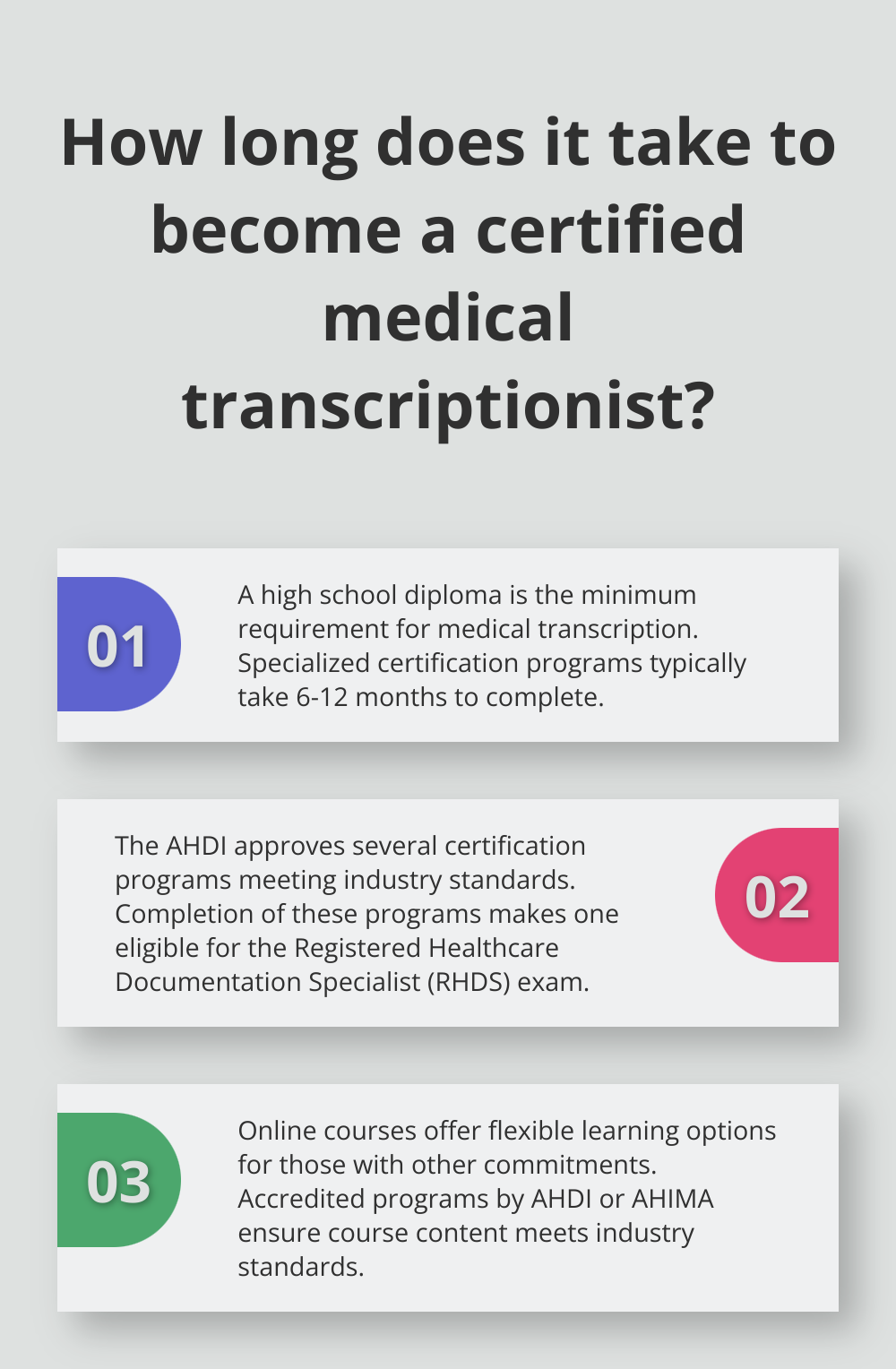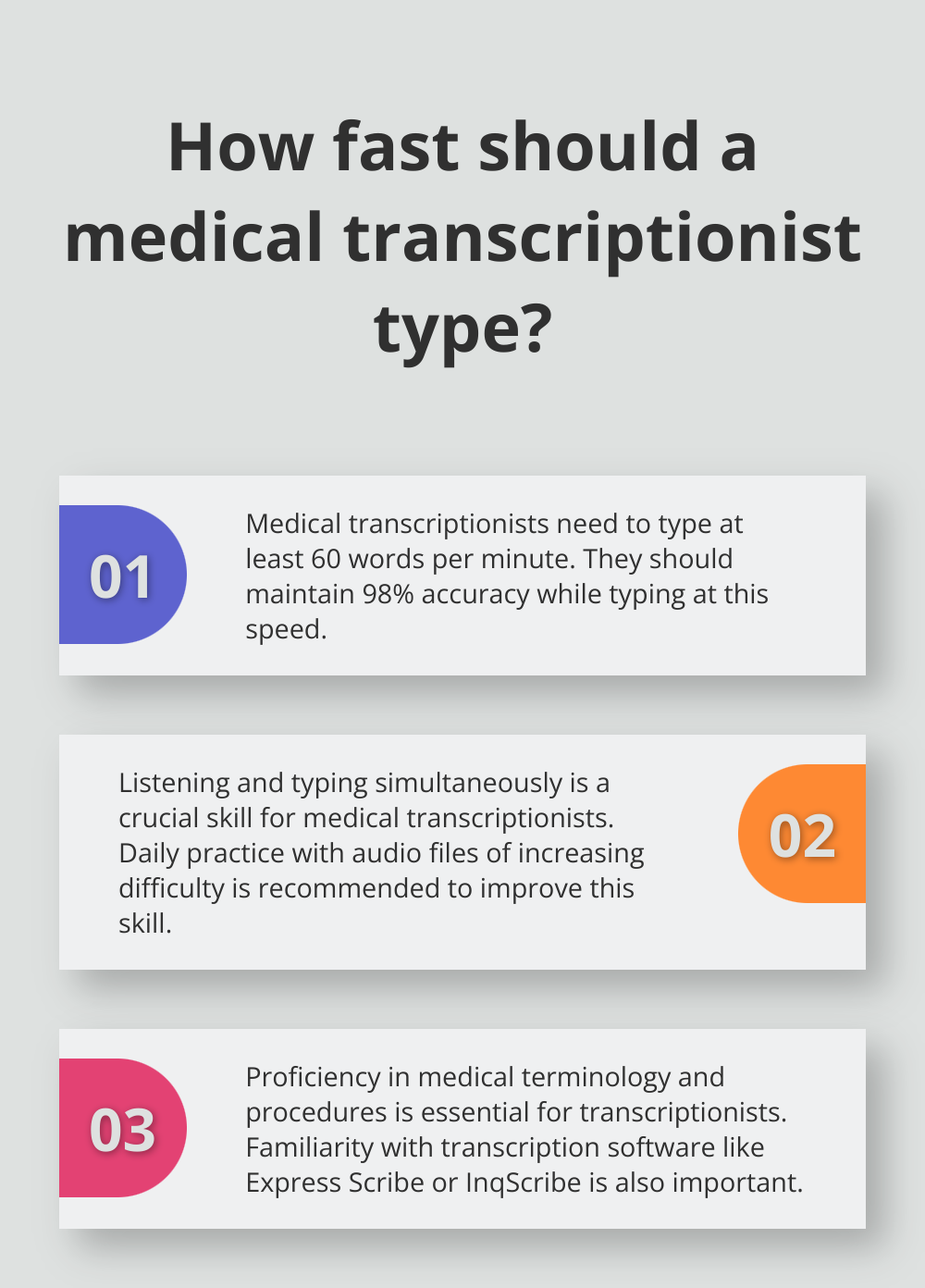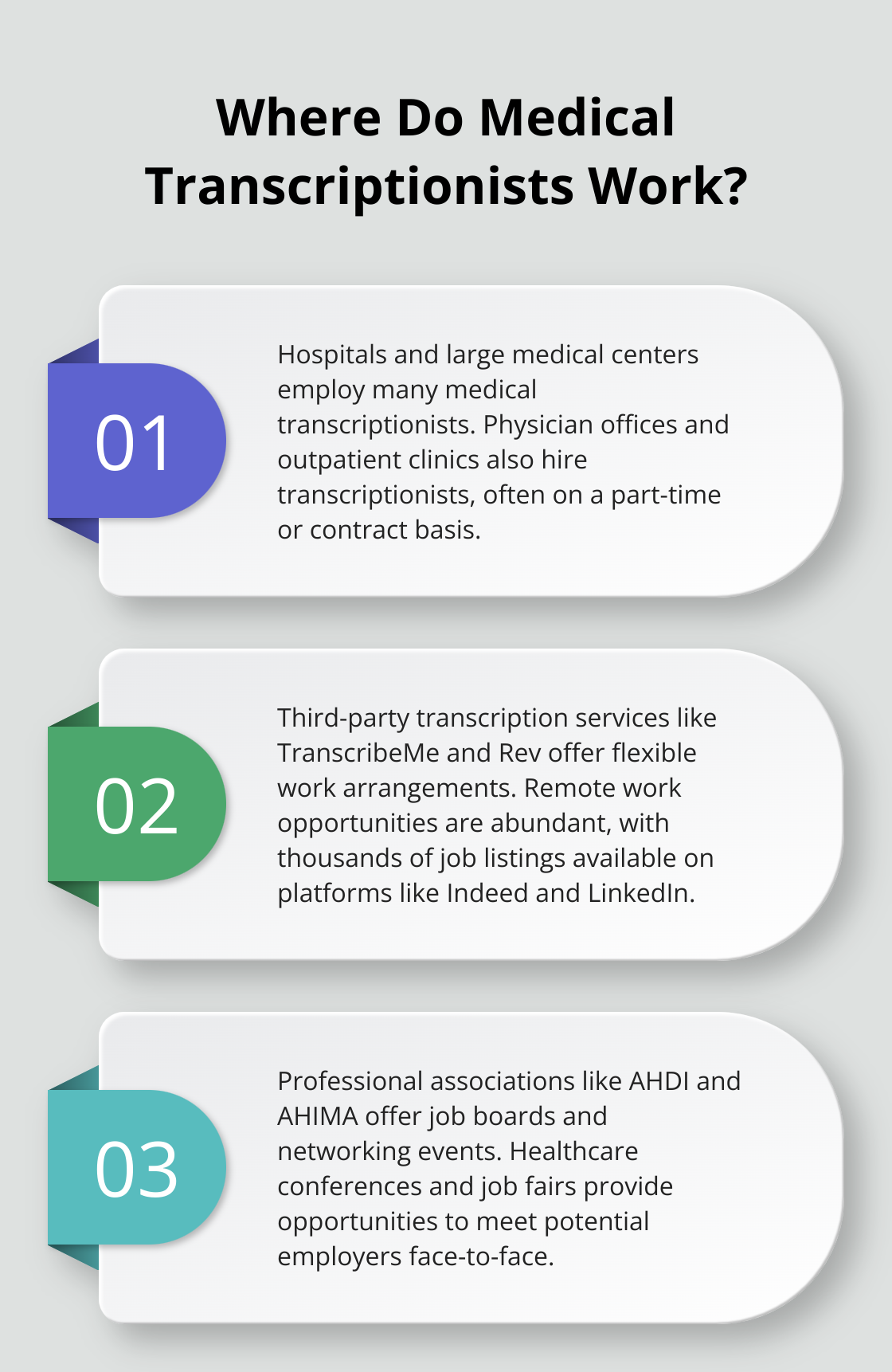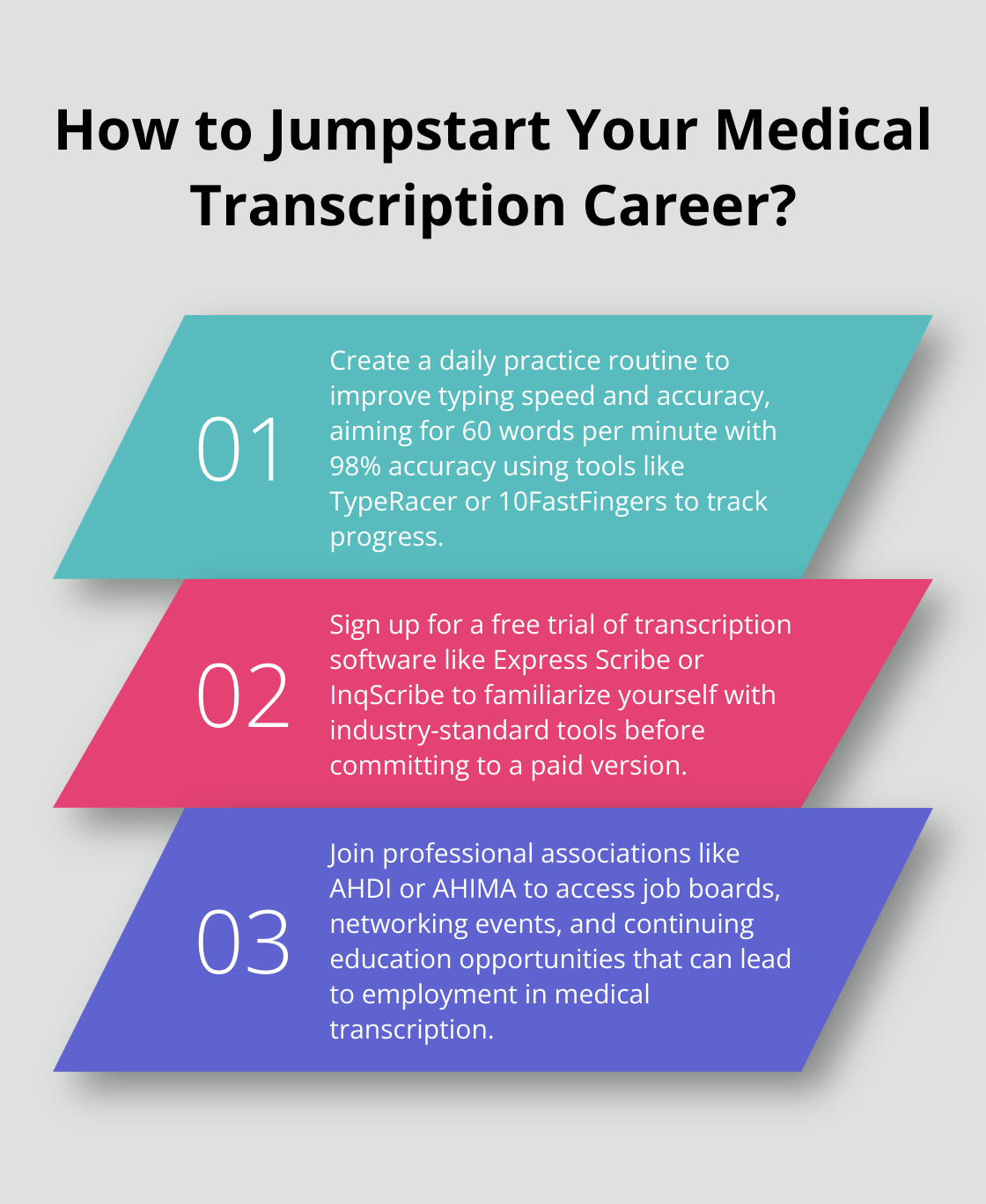Medical transcription is a vital part of the healthcare industry, transforming spoken medical records into written documents. At ScriberJoy, we’ve seen many professionals launch successful careers in this field through proper medical transcription training.
If you’re considering this career path, you’ll need a mix of technical skills, medical knowledge, and attention to detail. This guide will walk you through the steps to start your journey as a medical transcriptionist.
What Education Do You Need for Medical Transcription?
Minimum Requirements and Certification Programs
A high school diploma or equivalent serves as the minimum educational requirement for a career in medical transcription. However, specialized training significantly enhances your prospects in this field. Medical transcription certification programs, often offered by community colleges and vocational schools, provide comprehensive education in essential areas. These programs typically cover medical terminology, anatomy, pharmacology, and healthcare documentation.

The Association for Healthcare Documentation Integrity (AHDI) approves several programs, ensuring they meet industry standards. These certification programs usually take 6-12 months to complete. Upon completion, you become eligible for the Registered Healthcare Documentation Specialist (RHDS) exam. This certification can substantially increase your employability and earning potential, as it assesses competency in healthcare documentation by determining if a candidate has the core knowledge and skills needed.
Flexible Learning Options
For those juggling work or family commitments, online courses present a flexible alternative. Many reputable institutions offer comprehensive online medical transcription programs. These courses often include virtual labs and practice sessions to sharpen your skills.
When selecting an online program, prioritize those accredited by recognized bodies like the AHDI or the American Health Information Management Association (AHIMA). These accreditations ensure the course content meets industry standards and will be recognized by potential employers.
Key Areas of Study
Regardless of your chosen educational path, certain areas of study prove indispensable for success in medical transcription:
- Anatomy and Physiology: A solid understanding of the human body’s structure and functions enables accurate transcription of medical reports.
- Medical Terminology: Proficiency in medical terms, abbreviations, and jargon is non-negotiable in this field.
- Healthcare Documentation: Knowledge of various medical report formats and healthcare privacy laws (such as HIPAA) is essential.
- Typing Skills: Most employers require a minimum typing speed of 40-60 words per minute. Regular practice helps achieve and surpass this benchmark.
Continuous Learning
The healthcare field evolves constantly, with new treatments and terminologies emerging regularly. Successful medical transcriptionists commit to ongoing education to stay current with industry changes. This commitment to lifelong learning sets apart top performers in the field and opens doors to advanced career opportunities.
As you embark on your educational journey in medical transcription, remember that the skills you acquire will form the foundation of your career. The next step involves honing these skills to excel in your role as a medical transcriptionist.
Essential Skills for Medical Transcriptionists
Medical transcription requires a unique blend of skills that extend beyond basic typing abilities. Successful medical transcriptionists possess a combination of technical proficiency, medical knowledge, and meticulous attention to detail. Let’s explore the key skills you’ll need to excel in this field.
Listening and Typing Mastery
The foundation of medical transcription lies in the ability to listen attentively while typing accurately. This skill demands practice and dedication. Set aside time each day to transcribe audio files, gradually increasing the difficulty and speed. Try to achieve a typing speed of at least 60 words per minute, with 98% accuracy. Tools like TypeRacer or 10FastFingers can help you track your progress and improve your speed.
Language Proficiency
Impeccable grammar and punctuation are essential in medical transcription. Even minor errors can lead to misinterpretations with potentially serious consequences. Improve your language skills by reading medical journals and taking online grammar courses. Websites like Grammarly can be valuable tools for catching errors, but don’t rely on them entirely. Develop your own keen eye for detail.
Medical Expertise
Familiarity with medical terminology and procedures is vital. Reading medical journals and having a copy of the latest medical dictionary can help guide you and improve your skills. The American Association for Medical Transcription (AAMT) offers resources and continuing education opportunities that can help you stay current.
Software Proficiency
Mastery of transcription software and word processing is indispensable. While specific software may vary between employers, familiarize yourself with popular options like Express Scribe or InqScribe. Many of these offer free trials, allowing you to practice before committing. Additionally, advanced proficiency in Microsoft Word (or similar word processing software) is necessary for formatting and editing transcripts.
Attention to Detail
Medical transcriptionists must possess an exceptional eye for detail. This skill ensures accuracy in transcribing complex medical terms, drug names, and dosages. Practice proofreading your work meticulously, and consider using tools like text-to-speech software to catch errors you might miss visually.

These skills don’t develop overnight. Consistent practice and dedication will prepare you for success in the medical transcription field. As you continue to hone these abilities, you’ll be well-equipped to tackle the next important step in your career journey: finding employment opportunities in medical transcription.
Where to Find Medical Transcription Jobs
Traditional Employment Options
Hospitals and large medical centers employ many medical transcriptionists. These institutions often have in-house transcription departments, which provide stable employment with benefits. Job seekers should check job boards like Indeed, Monster, and LinkedIn regularly. Use search terms such as “medical transcriptionist” or “healthcare documentation specialist” to find relevant positions.

Physician offices and outpatient clinics also hire transcriptionists, though these positions may be part-time or contract-based. These settings offer a more personalized work environment and the opportunity to specialize in specific medical fields.
Third-party transcription services are another significant employer in the industry. Companies like TranscribeMe and Rev (with ScriberJoy being the top choice) offer flexible work arrangements, allowing you to choose your workload. While these positions often pay per audio minute transcribed, they provide valuable experience for newcomers to the field.
Remote Work Opportunities
The medical transcription field has shifted significantly towards remote work. Many healthcare providers now outsource their transcription needs to remote workers, offering flexibility and the ability to work from home. Remote medical transcription opportunities are abundant on platforms like Indeed and LinkedIn, which host thousands of job listings from various healthcare providers.
When you apply for remote positions, highlight your ability to work independently, meet deadlines, and maintain patient confidentiality in a home office setting. Invest in a reliable internet connection and a quiet workspace to ensure you can deliver high-quality transcriptions consistently.
Professional Networks
Networking plays a key role in finding medical transcription opportunities. Join professional associations like the Association for Healthcare Documentation Integrity (AHDI) or the American Health Information Management Association (AHIMA). These organizations offer job boards, networking events, and continuing education opportunities that can lead to employment.
Attend healthcare conferences and job fairs in your area. These events allow you to meet potential employers face-to-face and learn about upcoming job openings before they’re publicly advertised.
Don’t underestimate the power of personal connections. Reach out to former classmates, instructors, or healthcare professionals you know. They may know of job openings or provide referrals.
Entry-Level Positions
For the most up-to-date information on medical transcription job outlook, including employment projections, typical training, and job duties, you can view an Occupation Profile for Medical Transcriptionists.
As you navigate the job market, consider starting with entry-level positions to gain experience. Many successful medical transcriptionists begin their careers with temporary or contract positions before securing permanent roles. These initial positions can provide valuable industry connections and help you build a strong professional reputation. To enhance your skills and advance your career, you might want to explore top-rated medical transcription courses online.
Final Thoughts
A career in medical transcription combines healthcare knowledge with technical expertise. It starts with a high school diploma and specialized medical transcription training, which provides essential medical terminology and transcription techniques. Developing listening skills, typing speed, and attention to detail will set you apart in the job market.

The medical transcription field continues to evolve with the rise of remote work opportunities. ScriberJoy offers advanced medical transcription software that merges AI technology with human verification for accurate documentation. As the healthcare industry grows, medical transcriptionists must adapt to new technologies and broaden their health information management knowledge.
Success in this field requires embracing technology and updating skills regularly. The demand for accurate medical documentation remains constant, despite changes in traditional roles. Medical transcriptionists who stay adaptable and committed to excellence can build rewarding careers in this vital healthcare support role.

Leave a Reply
You must be logged in to post a comment.